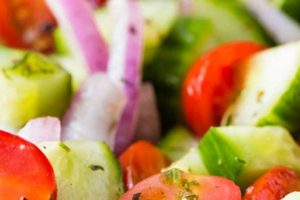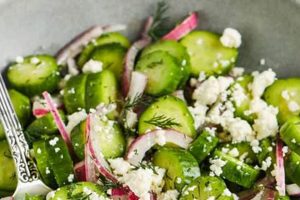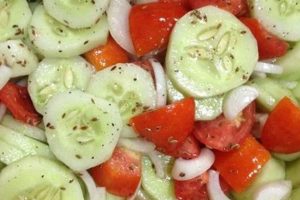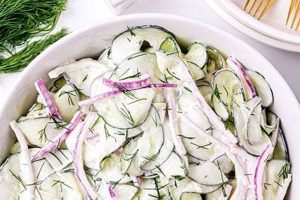A refreshing and often simple dish, this type of salad typically features thinly sliced cucumbers as the primary ingredient, complemented by a variety of other components. These additions can include herbs like dill or mint, vegetables such as onions or tomatoes, and a flavorful dressing often based on vinegar, yogurt, or sour cream. Variations exist across different culinary traditions, showcasing diverse flavor profiles and ingredient combinations. For instance, a Scandinavian version might incorporate sweeter elements, while a Mediterranean rendition might emphasize olive oil, lemon juice, and feta cheese.
Such salads are appreciated for their cooling properties, making them an ideal side dish during warmer months. The high water content of cucumbers contributes to hydration, while the added ingredients offer nutritional benefits depending on the specific recipe. Historically, cucumbers have been cultivated and consumed for millennia, and their incorporation into salads likely developed as culinary practices evolved. The simplicity of preparation, combined with the versatility of flavor combinations, has contributed to the enduring popularity of this culinary staple.
Further exploration will delve into specific regional variations, offer detailed preparation instructions for different recipes, and provide nutritional information for health-conscious individuals. From simple, everyday preparations to more elaborate presentations, the possibilities are vast and adaptable to a range of dietary needs and preferences.
Tips for a Perfect Cucumber Salad
Achieving optimal flavor and texture requires attention to detail throughout the preparation process. These tips offer guidance for creating a truly exceptional dish.
Tip 1: Salt and Drain Cucumbers: Salting sliced cucumbers draws out excess moisture, preventing a watery salad. Place the slices in a colander with salt and let them sit for at least 15 minutes before rinsing and patting dry.
Tip 2: Choose the Right Cucumber: English cucumbers are often preferred for salads due to their thin skin and fewer seeds. If using standard cucumbers, consider peeling and seeding them for a smoother texture.
Tip 3: Thinly Slice Cucumbers: Evenly thin slices ensure a consistent texture and allow the dressing to coat each piece effectively. A mandoline slicer or sharp knife can achieve optimal results.
Tip 4: Balance Flavors: The dressing should complement the cucumbers without overpowering their delicate flavor. A balance of acidity, sweetness, and savory elements creates a harmonious profile.
Tip 5: Chill Thoroughly: Chilling the salad for at least 30 minutes before serving enhances the refreshing qualities and allows the flavors to meld.
Tip 6: Add Herbs and Spices: Fresh herbs like dill, mint, or parsley elevate the flavor profile. A pinch of red pepper flakes can add a subtle kick.
Tip 7: Consider Additional Vegetables: Incorporating thinly sliced red onion, bell peppers, or tomatoes adds textural and flavor complexity.
By following these guidelines, one can elevate a simple cucumber salad from ordinary to extraordinary, creating a dish that is both refreshing and flavorful.
These tips provide a strong foundation for creating a delectable cucumber salad. Experimentation with different ingredients and flavor combinations allows for personalized variations tailored to individual preferences.
1. Ingredients
Ingredient selection significantly impacts the final flavor profile and overall quality of a cold cucumber salad. Careful consideration of each component contributes to a balanced and refreshing dish. The following facets explore key ingredient categories and their respective roles.
- Cucumbers:
The central element, cucumbers provide the foundational flavor and texture. Different varieties offer unique characteristics. English cucumbers, known for their thin skin and delicate flavor, are a popular choice. Alternatively, standard cucumbers, though thicker-skinned, can be peeled and seeded for a similar effect. The choice of cucumber influences the overall crispness and subtly impacts the final taste.
- Dressing:
The dressing provides the dominant flavor profile, complementing the cucumbers’ subtle taste. Vinegar-based dressings offer a tangy and refreshing element, while yogurt or sour cream-based dressings contribute a creamy richness. The balance of acidity, sweetness, and savory notes within the dressing is crucial for achieving a harmonious blend.
- Aromatics:
Aromatics, such as fresh herbs and spices, enhance the complexity and depth of flavor. Dill, mint, and parsley are commonly used, each imparting its unique character. A pinch of red pepper flakes can add a subtle heat, while garlic or ginger can introduce a more pungent note. The careful selection and combination of aromatics elevate the salad beyond its basic components.
- Additional Vegetables:
Incorporating other vegetables adds textural and flavor complexity. Thinly sliced red onion provides a sharp bite, while bell peppers contribute a sweet crunch. Tomatoes introduce a juicy element, and other vegetables, such as radishes or carrots, can further enhance the salad’s nutritional value and visual appeal. These additions broaden the sensory experience and offer opportunities for creative combinations.
The interplay of these ingredient categories determines the final character of the cold cucumber salad. A thoughtful approach to selection, considering the desired flavor profile and textural elements, ensures a well-balanced and satisfying dish. Experimentation with different combinations within these categories allows for endless variations and personalized culinary creations.
2. Preparation
Proper preparation techniques are essential for optimizing the flavor, texture, and overall quality of a cold cucumber salad. These techniques ensure that the cucumbers retain their crispness while allowing the flavors of the dressing and other ingredients to meld harmoniously. The following facets delve into key preparatory steps.
- Slicing:
The way cucumbers are sliced significantly impacts the final presentation and texture of the salad. Thin and even slices ensure a pleasant mouthfeel and allow the dressing to coat each piece effectively. Uniformity in slicing also enhances the visual appeal of the dish. While a sharp knife can achieve satisfactory results, a mandoline slicer offers greater precision and consistency.
- Salting and Draining:
Cucumbers contain a high water content, which, if not addressed, can lead to a watery salad. Salting the sliced cucumbers draws out excess moisture. Placing the salted slices in a colander for at least 15 minutes, followed by rinsing and thorough patting dry, ensures a crisper, more flavorful salad.
- Chilling:
Chilling the prepared salad enhances its refreshing qualities. Allowing the salad to rest in the refrigerator for at least 30 minutes before serving allows the flavors of the dressing and other ingredients to meld, resulting in a more cohesive and balanced flavor profile.
- Combining Ingredients:
The order and manner in which ingredients are combined can affect the final outcome. Generally, the dressing should be added to the cucumbers and other vegetables just before serving to prevent the salad from becoming soggy. Gentle tossing ensures even distribution of the dressing and prevents damage to delicate ingredients.
These preparatory steps are crucial for maximizing the enjoyment of a cold cucumber salad. Attention to detail in each stage ensures that the final dish is not only visually appealing but also offers a delightful textural and flavor experience. Proper preparation elevates the simple combination of ingredients into a refreshing and satisfying culinary creation.
3. Flavor Profile
The flavor profile of a cold cucumber salad is a critical determinant of its palatability and overall success. This profile arises from the complex interplay of various ingredients and their inherent taste characteristics. A well-balanced profile typically incorporates elements of acidity, sweetness, saltiness, and often a hint of bitterness or spice. These elements harmonize to create a refreshing and nuanced culinary experience. For instance, a classic cucumber salad with vinegar and dill exhibits a bright, tangy flavor profile, while a creamy cucumber salad with yogurt and mint offers a smoother, more herbaceous taste.
The careful manipulation of ingredients allows for a wide range of flavor profiles, catering to diverse preferences. Acidity, often derived from vinegar or citrus juice, provides a refreshing tartness that cuts through the cucumber’s subtle sweetness. Sweetness, which can be introduced through sugar, honey, or even certain varieties of onions, balances the acidity and adds depth. Salt enhances the other flavors and prevents the salad from tasting bland. Herbs and spices contribute complexity and aromatic notes, further enriching the overall sensory experience. A salad featuring cucumbers, red onion, and a rice vinegar dressing exemplifies a balance of sweet, sour, and pungent flavors, showcasing the dynamic interplay achievable through ingredient selection.
Understanding the impact of individual ingredients on the final flavor profile empowers culinary creativity and customization. Achieving a desirable balance requires careful consideration of each component’s contribution. Challenges may arise from overpowering certain flavors or failing to achieve a harmonious blend. However, thoughtful experimentation and attention to detail allow for the creation of unique and satisfying flavor profiles tailored to specific tastes. Whether the goal is a classic, tangy salad or a more complex, nuanced creation, mastering the interplay of flavors is paramount to a successful cold cucumber salad recipe.
4. Cultural Variations
Cultural variations significantly influence the preparation and presentation of cold cucumber salads, reflecting diverse culinary traditions and regional preferences. These variations extend beyond simple ingredient substitutions to encompass distinct flavor profiles, cutting techniques, and accompanying dishes. Examining these cultural nuances provides valuable insights into the adaptability of this seemingly simple dish and its integration into various culinary landscapes.
In many Asian cuisines, cold cucumber salads often feature a balance of sweet, sour, and spicy flavors. For example, Japanese sunomono utilizes rice vinegar for its mild acidity and sweetness, often incorporating seaweed and sesame seeds for added texture and umami. Korean oi muchim, on the other hand, frequently includes gochugaru (Korean chili flakes) for a fiery kick, balanced by the sweetness of sugar or gochujang (Korean chili paste). These examples highlight how regional ingredients and flavor preferences shape the final dish, creating distinct culinary experiences.
European variations offer a different perspective. In Eastern European countries, a simple salad of thinly sliced cucumbers dressed with sour cream, dill, and sometimes vinegar is a common accompaniment to heavier meals. Greek tzatziki, although technically a dip, shares similarities with cucumber salad, incorporating yogurt, garlic, and dill for a refreshing and tangy flavor profile. These preparations showcase how regional ingredients, such as readily available herbs and dairy products, influence culinary traditions.
Understanding these cultural variations offers valuable context for appreciating the versatility and global appeal of cold cucumber salads. It highlights how a seemingly basic dish can be transformed through the lens of different culinary traditions, resulting in a diverse range of flavors and textures. This exploration underscores the importance of cultural context in shaping culinary practices and broadening culinary horizons, demonstrating the adaptability of a single dish across geographical boundaries.
5. Serving Suggestions
Serving suggestions represent a crucial aspect of any cold cucumber salad recipe, extending beyond mere presentation to significantly enhance the overall dining experience. Appropriate serving suggestions elevate the dish by considering complementary flavors, textural contrasts, and optimal temperature pairings. These considerations transform a simple side dish into a well-integrated component of a complete meal, amplifying its culinary impact.
Consider a classic cucumber salad with a dill and vinegar dressing. Its bright, acidic profile makes it an ideal accompaniment to rich, savory dishes such as grilled meats or smoked fish. The refreshing coolness of the salad cuts through the richness of the main course, creating a balanced and harmonious palate experience. Conversely, a creamy cucumber salad with yogurt and mint pairs well with spicier cuisines, such as Indian or Thai dishes. The cooling yogurt base helps to temper the heat of the spices, while the mint adds a refreshing herbaceous note. These pairings illustrate how serving suggestions can strategically enhance the overall meal by considering complementary flavor profiles and contrasting textures.
Practical applications of appropriate serving suggestions extend to various culinary contexts. In a formal setting, a meticulously plated cucumber salad with edible flowers and a delicate vinaigrette can serve as an elegant appetizer. For a casual meal, a simple cucumber salad in a large bowl can be a refreshing side dish shared family-style. Understanding these nuances allows one to tailor the presentation and serving style to the specific occasion, demonstrating the versatility of this dish. Challenges may include balancing flavors and textures, particularly when dealing with complex or multi-faceted dishes. However, a thoughtful approach to serving suggestions ensures that the cold cucumber salad not only complements the meal but also enhances the overall culinary narrative.
Frequently Asked Questions
This section addresses common inquiries regarding cold cucumber salad recipes, providing clear and concise information to assist in preparation and enhance understanding of this versatile dish.
Question 1: How can excess moisture be prevented in a cucumber salad?
Salting sliced cucumbers draws out excess water. Place cucumber slices in a colander, sprinkle with salt, and let sit for 15-30 minutes. Rinse and pat dry before adding to the salad.
Question 2: What type of cucumber is best suited for cold salads?
English cucumbers, with their thin skin and fewer seeds, are often preferred. Standard cucumbers can be used but may benefit from peeling and seeding.
Question 3: What are common dressing options for cucumber salads?
Vinegar-based dressings provide a tangy flavor, while yogurt or sour cream-based dressings offer a creamy texture. Other options include lemon juice, olive oil, and various herbs and spices.
Question 4: How long can a cold cucumber salad be stored?
Properly stored in an airtight container in the refrigerator, a cucumber salad can typically last for 2-3 days. However, its quality and crispness may diminish over time.
Question 5: Can other vegetables be added to a cucumber salad?
Adding other vegetables enhances flavor and texture. Common additions include tomatoes, onions, bell peppers, and radishes. The choice of additional vegetables depends on desired flavor profiles and personal preferences.
Question 6: How can one adapt a cucumber salad to different dietary restrictions?
Dietary adaptations can be easily accommodated. Vegan versions can utilize plant-based yogurt and omit dairy-based ingredients. Adjustments to sugar content can address diabetic concerns. Ingredient substitutions can cater to specific allergies or intolerances.
Addressing these frequently asked questions provides a foundational understanding of preparing and enjoying cold cucumber salads. Further exploration and experimentation with different ingredients and techniques can lead to personalized variations tailored to individual preferences and dietary needs.
The following section provides specific recipe examples demonstrating the principles discussed above.
Conclusion
Exploration of this culinary staple reveals a dish adaptable to a multitude of flavor profiles and culinary traditions. From the selection of cucumbers and complementary ingredients to the careful balance of flavors in the dressing, each step contributes to the final product. Proper preparation techniques, such as salting and chilling, are essential for optimizing texture and taste. Regional variations showcase the dish’s versatility, demonstrating its adaptability across diverse culinary landscapes.
This seemingly simple salad offers a canvas for culinary creativity, allowing for personalized interpretations limited only by imagination and ingredient availability. Further exploration and experimentation promise a rewarding journey through the diverse world of flavor and texture offered by this refreshing and versatile dish. The potential for innovation within this culinary framework remains vast, inviting continued exploration and refinement of techniques.






